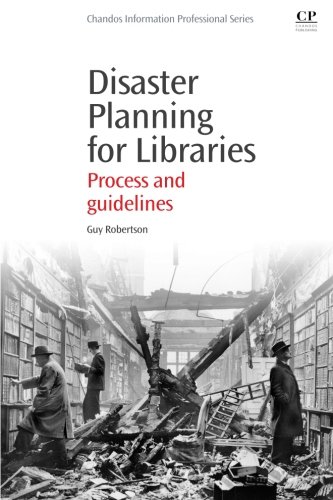 Editor’s Note: This post is by Randy Silverman. Randy is the Preservation Librarian at the University of Utah’s Marriott Library.
Editor’s Note: This post is by Randy Silverman. Randy is the Preservation Librarian at the University of Utah’s Marriott Library.
Guy Robertson’s Disaster Planning for Libraries: Process and Guidelines, is long on lists and short on practical advice for putting together a succinct disaster plan. Its strength is in risk identification and includes inventories of possible threats including toxic spills, train derailments, and nuclear power plant failures. Its weakness lies in the limited number of insights it offers for actually addressing these hazards.
While well organized—the work is largely a compilation of bullet points—the focus appears to be generic corporate disaster planning with barely a mention of the issue that differentiates libraries—collections. The word ‘book’ occurs only five or six times in a text of 123 pages (an additional 70 pages of appendices follow), and the general recommendation seems to be, if it’s damaged, throw it out. This dovetails nicely with the reoccurring theme that major mishaps represent an opportunity for institutions to “upgrade” their shabby possessions—be that furniture, IT hardware, or the building itself. All well and good, if there is money in the bank or the library has a hefty insurance policy in place—but insurance is never discussed.
Special collections are touched on twice as though the topic were foreign territory. The section entitled, “Key post-disaster vendors for resumption and continuity,” for example, instructs the reader to create a strategic alliance with conservators to deal with material such as “French, Venetian and English incunabula.” The exoticism continues at the text’s end when a “Head Librarian” is quoted as saying “libraries should have conservators on call,” because the “conservation of a fifteenth-century herbal will differ from that of a modern first edition.” Determining when it is judicious to dry, repair, discard, or replace collections is lacking, much less instructions for orchestrating these tasks. Mold or vacuum freeze drying are not addressed.
The book’s coverage of recovery issues is summarized as setting “aside damaged books . . . for assessment by library staff,” followed by a review using the “Bibliotriage” matrix. This template would allow someone to approximate the number of each collection type having “severe,” “serious,” “moderate,” or “light” damage. Clues for differentiating between “severe” or “serious” are not provided, nor is it clear how this information should be used. Perhaps the totals are intended to inform the insurance company (if one exists) about how much to compensate the library for its “upgrade;” we will never know.
The most significant reminder provided in Disaster Planning for Libraries is how useful it is for libraries to keep their disaster plan simple—but Robertson fails to demonstrate how to do that in favor of providing interminable lists of things planners should not forget to consider. The readily available, two-page template called the Pocket Response Plan for Collections (Council of State Archivists or Western States and Territories Preservation Assistance Service) goes unmentioned. Instead, the author opts to include numerous interviews with anonymous librarians from the U.S., Canada, and the U.K. intended to deliver firsthand experiences, yet these conversations are not authoritative.
Readers with an interest in disaster preparedness should consider consulting the existing literature. A number of well-tested books on the topic already exist and should prove readily available—An Ounce of Prevention: Integrated Disaster Planning for Archives, Libraries, and Record Centres, (2002); Help! A Survivor’s Guide to Emergency Preparedness (2001); Field Guide to Emergency Response (2006); and Building an Emergency Plan: A Guide for Museums and other Cultural Institutions (1999). Unless, of course, these publications were discarded during the last “upgrade.”



